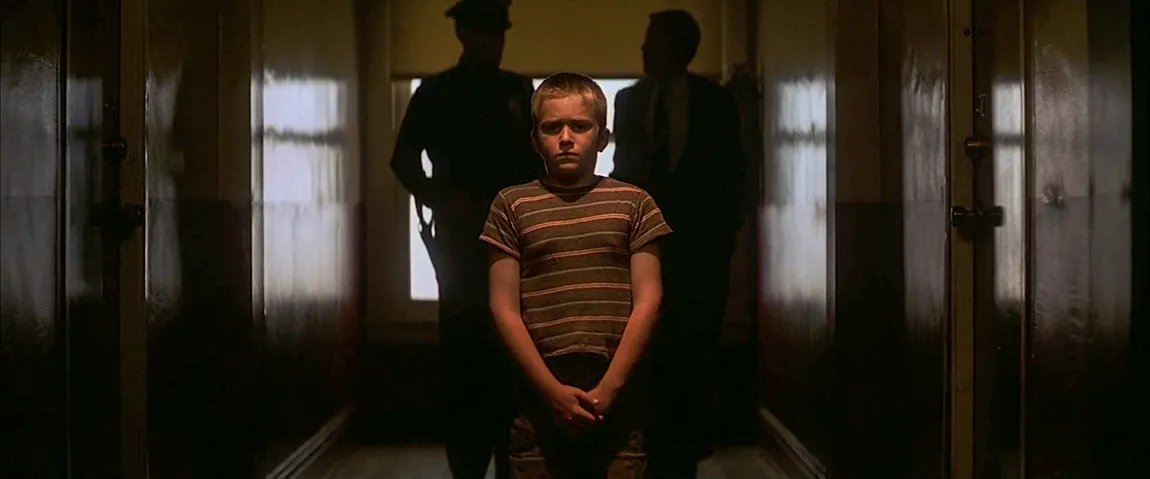An Introduction on a Prologue
To start this collection of essays on Paul Thomas Anderson’s Magnolia, I direct your attention to something decidedly minor: a boy perhaps nine or ten years old, an unnamed secondary character in the last of the three brief tales that open the movie.
Newest Essays
“but it did happen”: The Importance of Four Words in the Corner
Kiss, Interrupted: “Say it, Jimmy”/“Just let me go, Jim”
The Unseen Ending: The Death of Jimmy Gator
An Active God, Acts of God: Dixon as an Agent of the Divine
The Kid in the Hall: An Introduction on a Prologue
Prisoner and Preacher: Earl Partridge
Why Are There Frogs Falling from the Sky?
But there he is, and Anderson makes a point of spotlighting him.
In this final prologue about a suicide attempt by Sydney Barringer that turned into his murder, the camera moves down a busy hallway, finding two backlit figures: a boy, dwarfed and partially obscured by a cop. The kid is talking, but it’s hard to pick out what he’s saying because of the voice-over and the score. When the officer calls to a colleague, the child is in danger of falling out of the frame.
What he’s saying is clearly important to the story being told, but the person himself seems unimportant. The narrator, who to this point has packed his tellings with irrelevant specifics, merely refers to him as “a young boy who lived in the building, sometimes a visitor and friend to Sydney Barringer” and never mentions him again.
Anderson cuts to a flashback of Sydney loading the shotgun that will kill him. The camera circles, and the younger boy is revealed behind him, out of focus but clearly with his hands in front of his mouth, concerned.

Then we’re back in the hallway, empty this time but for the kid standing alone, arms folded across his chest. Again, he’s backlit, and again the camera comes closer. We hear his testimony, presumably to the press: “He said that he wanted them to kill each other, and that’s all that they wanted to do is to kill each other, and that he would help them do that if that’s what they wanted to do.” And as the camera gets near, the boy’s features emerge, until a camera flash illuminates him fully. And there ends the boy’s usefulness in terms of the story.
After the situation is diagrammed on-screen, Sydney’s mother Fay is handcuffed, and the narrator blathers on about coincidences that can’t just be coincidences. For no obvious reason, there’s the boy in the hallway again, looking uncomfortable and shifting his shoulders, a cloudy look on his face. The camera comes at him, and two silhouetted figures approach him from behind and eventually leave the frame. He is alone.
Fay struggles with the officers. The published screenplay directs: “[I]n the scuffle, the apartment door is shut directly in the face of the CAMERA. CUT TO BLACK.” And that’s when Magnolia proper is supposed to start.
But in the movie there’s the boy again in tight, slightly zooming closeup. This final prologue shot lasts just a second or two. Machine-gun fire, swelling music, and the narrator finishing the line “These strange things happen all the time” compete for attention on the soundtrack. The light on the boy’s face is cut, with a frame or maybe two without artificial lighting — leaving some illumination from the window behind the boy.
This is not just something that happens.
Magnolia is littered with character pairings and echoes, and the kid in the hall has a partner in Dixon, another minor player who similarly helps explain a death. He is also a child thrust (however briefly) into the spotlight, like Stanley and Donnie.
Yet in the kid’s prominent placement, he is even more important: a subtle and clear cue from Anderson to pay attention to children. The movie’s writer and director — the real storyteller — slyly subverts his narrator character, who has little use for the youngster as a human being; he is a nameless expository tool.
This prologue is obviously Sydney’s story, a tragedy of bad parenting. But Sydney is dead, and the boy in the hallway is not. He will carry the scars of this incident for the rest of his life.
He is Stanley, and also Donnie, and Frank, and Claudia.
He is damage.

